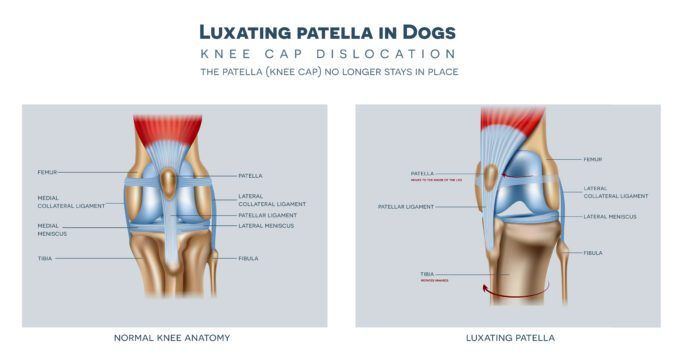Usually, a luxating patella is first noticed when a young dog occasionally “skips” on a walk or when running, looking sort of three-legged. Often, after a stride or two, the dog stretches his leg, and all is good.
A luxating patella is a kneecap that moves in and out of place. In other words, the kneecap becomes misaligned and then shifts back into place in the femoral groove in the knee joint. The longer it goes on without correction, the worse things often get.
While this happens more often in small breeds than larger dogs, luxating patellas can occur in any dog. With larger dogs, additional problems like hip dysplasia may also be noticed, and the overall prognosis can be worse than for smaller dogs.
A luxating patella can be due to injury or genetics, and it is usually first noticed in younger dogs. An untreated luxating patella can become painful, leading to arthritis and other knee problems, like cranial cruciate ligament tears difficulties.
Surgical Treatment
Depending on the degree of the dog’s luxating patella and your plans for that dog, your veterinarian may recommend surgery with an orthopedic surgeon to restore normal movement and minimize the development of arthritis.
Costs for luxating patellar surgeries vary from $1,500 to $5,000 or more, depending upon the size of the dog, the exact procedure required, as well as anesthesia and pre/post operative requirements. Post-surgery rehabilitation is also normally required, at an additional cost, of course.
Do Braces Work?
Many commercial braces are available for dogs with patellar problems. Whether a brace will work or not depends heavily on exactly what your individual dog is battling and how bad the luxating patella is.
Always discuss the use of a brace with your veterinarian before spending money on one and set up an appointment for your veterinarian to fit the brace for your dog before you use it. Ideally, you will purchase a custom brace, but you should still ask your vet to help you ensure it fits correctly.
Be careful with braces. Very often, you get what you pay for. In general, most veterinarians find that surgery provides a better long-term solution and many do not recommend braces.
Exercise
Most dogs with mild luxating patellas should walk and exercise regularly. Exercise helps your dog maintain a healthy body weight and the muscles, tendons, and ligaments that support the knee joint.
If your dog is participating in a sport that requires flat-out running, like FastCAT, or jumping, like agility, discuss these sports with your veterinarian before continuing training.
Prevention
Most luxating patellas are due to genetic conformational defects. High-risk breeds include:
- Bichon
- Bulldog
- Cavalier King Charles Spaniel
- Chihuahua
- French Bulldog
- Jack Russell Terrier
- Lhasa Apso
- Pomeranian
- Poodle
- Pug
- Shit-tzu
- West Highland White Terrier
- Yorkshire Terrier
If you are considering one of these breeds, it helps to find a puppy whose parents have been certified free of luxating patellas via the Orthopedic Foundation for Animals (OFA).
Keeping your dog fit, exercising appropriately for his level of fitness, and ensuring he stays at a healthy weight will minimize risk.






